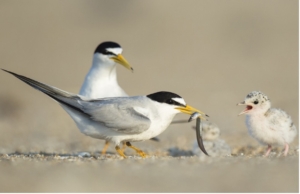Conservation in Connecticut
Shorebirds and Seabirds On The Decline
By Barbara Heimlich
Editor
Source: Audubon Connecticut; State of Connecticut
One of the state’s most vulnerable endangered bird species is the Least tern. Come October, law enforcement officers will be able to issue infractions to dog owners whose unleased dogs destroy nests of endangered shorebirds and seabirds, as well as citizens that don’t heed the warnings and signs of protection for our venerable bird population. Those who violate a new state law that protect nesting shorebirds will be ticketed, and fined as much as $20,000.
According to the bill, the Commissioner of Energy and Environmental Protection may designate seabirds and shorebird protection areas from a list of endangered species during the period of March 1st to September 15th. An infraction can be issued to any person who enters a seabird or shorebird protection area identified with string fencing, posts or signage.

“Every single nest matters for this threatened bird,” Audubon Connecticut’s Coastal Program Coordinator Elizabeth Amendola said. “Compared to 10 years ago, the number of breeding pairs of least terns nesting in the state has decreased by almost half.”
The birds, which had 247 nesting pairs at a handful of beaches in Connecticut in 2022, are about the size of a robin and have black-gray wings, a yellow beak and white body with a black “cap” on their heads, Audubon Director of Bird Conservation Corrie Folsom-O’Keefe said Wednesday. They typically arrive the first week of May and finish incubating their eggs around the middle of June.

Least Terns
Folsom-O’Keefe said there are only four places in the state where least terns can nest. “We’re fortunate to be able to share our shores with these birds,” Folsom-O’Keefe said. The 247 pairs of Least Terns we monitored fledged 211 chicks, adding up to a productivity of 0.85 fledglings per pair. This is the highest number of fledged least terns we’ve had in years, and significantly higher than the 0.11 productivity from the 2021 nesting season.
According to Folsom-O’Keefe all three of our focal species—Piping Plovers, American Oystercatchers, and Least Terns, all of which habitat and nest in Stratford—had excellent nesting seasons in 2022!
Piping Plovers nest in only 14 of the 25 towns and cities along the Sound in Connecticut, and they nest only on untrammeled beaches – the more that people and dogs use a beach, the less likely Piping Plovers are to successfully nest. Long Beach is one of those 14 towns that fit into that category. Among other things, the barrier beach helps protect the Great Meadows salt marsh and it provides excellent habitat for Piping Plovers, a federally threatened species. Over the last 22 years, Piping Plovers have done OK at Long Beach: 144 pairs have nested there, an average of 6.5 pairs a year. In a state where only 748 pairs have nested in total over that same period, that’s a significant percentage. For threatened and endangered species, every fledged chick is a success. The monitored 66 pairs of Piping Plovers during the 2022 season produced 97 total fledglings, adding up to a productivity of 1.51 fledglings per pair. Compared to the 2021 nesting season, there were more pairs, more fledged chicks, and a higher productivity—all sure signs that the population is growing!

Piping Plovers

Yes, Piping Plover Chicks are this small!
American Oystercatchers also had a successful breeding season, with 79 confirmed breeding pairs out of a population of 200 individuals—an increase of 28% over the last decade. These pairs successfully fledged 62 chicks, amounting to a productivity of 0.78 fledglings per pair. This is higher than the 0.5 fledglings per pair recovery goal for this species, and our highest number of fledged chicks since we started this work in 2012.

American Oystercatcher: Photo by On The Wings Photography, Mia McPherson
Bands for Birds: Catching and banding fledgling American Oystercatchers helps us understand how to conserve them. According to Audubon to date, we have banded 45 adults (making up 28% of Connecticut’s breeding population) and 17 pre-fledge chicks. The bands allow us to learn all about where birds go, and when, so we can better understand their movements and what it will take to conserve these birds.
This year, we got a surprise visit from two birds we had banded in 2020 and hadn’t sighted since—the first of the 17 chicks we’ve banded to be re-sighted returning to CT! You can help the American Oystercatcher banding project by reporting any sightings of banded oystercatchers to the American Oystercatcher Working Group. https://amoywg.org/
People Power: For the first time since 2020, our volunteer numbers returned to their pre-Covid numbers. As a result of holding our annual training virtually, we were able to reach a record number of 173 volunteers this season. All of their hard work added up to an amazing 1,376 volunteer hours.
With the help of our volunteers, techs, interns, and WildLife Guards, we were able to set up string fencing, install enclosures, monitor our many pairs of nesting shorebirds, and spread the word on protecting beach-nesting birds by engaging with beachgoers, boaters, and other members of the public.
Partnerships with Connecticut’s environmental conservation officers and the Connecticut Dept. of Energy and Environmental Protection Boating Division also helped us expand our outreach capabilities.
“2022 was a very successful year for CT’s beach-nesting birds thanks to hundreds of volunteers, field staff, wildlife guards, municipalities, and partners,” explains Corrie Folsom-O’Keefe, Audubon CT’s Director of Bird Conservation. “We are so thankful for to everyone for their time and efforts protecting our birds and their habitats!”
If you are interested in being a volunteer to help our shorebirds and seabirds to these websites for more information and to sign up:
https://ct.audubon.org/news/wildlife-guards-advocate-birds-beaches-and-general-assembly

